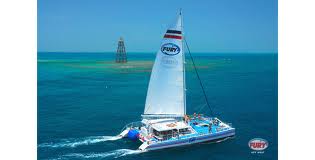At least once or twice a week I am approached by someone who wants to have one of my composite cats done in aluminum. Usually they don’t care that the result will be up to 50% heavier, have more complicated interior, and have no insulation, compared to a composite one.
They like the idea that they can hit a rock and presumably not have to stop. There are a couple of assumptions in the mix that are usually not noted.
For whatever reason, alum. cats are usually done by fishboat builders. Fair and smooth is not even a concept, compared to what efficient catamarans must have. I recall hearing that Atlantic Fury was up to 3/4″ out in places.
For fishboats, that’s no big. They just pile on the horsepower to make up for it. With a rough bottom like that, driving around with rock damage is not an issue. If the boat didn’t sink, nobody cares. Until they have to pay for the fuel.
Again, for any cat to move well, it must not only be light, but also be extremely fair and smooth. It doesn’t matter if it’s composite or aluminum, a gouge will slow the boat down and require more fuel. And any unrepaired gouge will attract marine growth and further slow it down. And again, the fishboat guys don’t care about efficiency. We do. The word catamaran means something very different to a fishboat builder, compared to a design that moves well. The work-around for fishboat builders is to basically bog up a composite hull on the outside of the aluminum hull to make it fair enough. But even with that is done, if the idea is that you can crash aluminum and not have to repair it is followed, you will be reducing that efficiency.
And always I wonder, if you have an aluminum cat with an added composite hull outside, and basically a composite hull inside to insulate it, why the alumimum again?
In summary, smooth and fair are important for catamarans, but are often forgotten in building aluminum ones. And don’t forget that there have been big advances in impact resistance of composite hulls compared to the polyester ones of 30 years ago.
